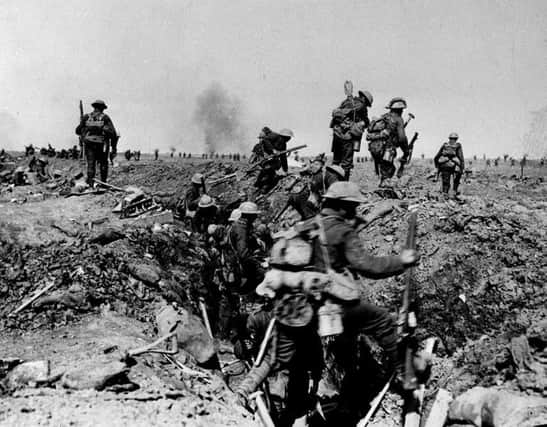Remembering the Sunderland heroes who died at The Somme


Friday marks the 100th anniversary of the first day of the Battle of the Somme where tens of thousands of allied troops were killed or wounded in a mass advance on the German lines.
In the coming days, we will take a closer look at some of the Wearside connections to the battle including the Sunderland men who gave their lives.
Advertisement
Hide AdAdvertisement
Hide AdOf the 250 plus men with connections to the then Sunderland Cricket and (Rugby) Football Club, many saw action on the Somme.
Club archivist Keith Gregson tells us more.
Exactly how many men with club connections served at the Somme is difficult to calculate.
But six members were killed in action or died from wounds in July 1916 alone.
We will look at those heroes with club connections this week.
Advertisement
Hide AdAdvertisement
Hide AdAnd we start by remembering Percy Douglas Robinson, Gordon Haswell and Joseph Michael Day.
l Sunderland-born Percy came into the world in 1888.
He was the son of an estate agent in Brookside Terrace and went to Exeter College, Oxford. He seemed destined to go places.
By 1911, he was an articled clerk in Ealing and a solicitor by 1912. He married the daughter of the vicar of Middleham in 1913.
But then, as Britain prepared for war, he joined the Northumberland Fusiliers in September 1914 and was promoted to 2nd lieutenant within a month. He was later installed as temporary captain.
Advertisement
Hide AdAdvertisement
Hide AdHe was on the front line by July 1915 and was killed in action at Contalmaison on the Somme on July 7, 1916.
His name appears on the casualty list published on July 24. He is also remembered on the Thiepval Memorial and his College’s Roll of Honour.
And tragically, it appears there was a posthumous son.
A copy of the telegram announcing his death was sent to his wife at the vicarage in Middleham.
l Gordon Haswell, born in Sunderland in 1892, went to Bede School and lived in Thornhill Gardens.
Advertisement
Hide AdAdvertisement
Hide AdHe was living with his brother Fred and the rest of the family in both 1901 and 1911.
He already had the war in mind when he was at Armstrong College (now Newcastle University) as he was a member of the Officers’ Training Corps.
By 1913, he was teaching English and History at Harrow County School where he was also involved with the scout troop.
As war beckoned, he joined up in October 1914 and was serving as a captain in the 9th Battalion of the Kings Own Yorkshire Light Infantry.
But fate tragically struck on July 1, 1916.
Advertisement
Hide AdAdvertisement
Hide AdHe was in No Man’s Land when he was caught in the middle of heavy fire and killed.
Heartbreakingly just hours earlier, he was the captain who - on the night before battle - had given the final toast to his regiment.
He told them: “Gentlemen, I give you the toast of the King’s Own Yorkshire Light Infantry, and in particular the 9th Battalion of the Regiment.”
Of the 24 officers in the room who went into action the next day, only one emerged totally unscathed.
Advertisement
Hide AdAdvertisement
Hide AdThe bodies of those killed were recovered from the battlefield and buried in Norfolk Cemetery.
l Joseph Michael Day, born in 1894, had a twin brother George.
They were the youngest of seven and in 1901 his father was recorded as a retired marine engineer.
In 1901, the family was living in Argyle Square but by 1911 it had moved to Harrogate where Joseph was serving as a chemist’s apprentice.
Advertisement
Hide AdAdvertisement
Hide AdHe was a club member in 1907 at the age of 13 and served as a private in the Army Service Corps, having returned to Sunderland to join up.
His medal cards indicate that he entered the Western Front in July 1915 and died of wounds on the Somme on July 7, 1916.
The indications are that he was working with a field ambulance section.
He was posthumously awarded the regulation two service medals and the 1915 star.
He is buried in the Warloy-Baillon Community cemetery extension on the Somme. His name is in the Book of Remembrance in Holy Trinity Church and also on the Christchurch Monument.